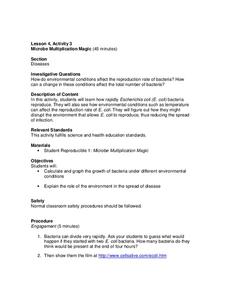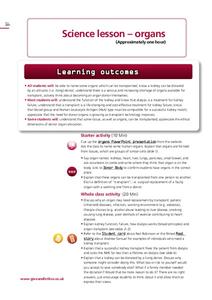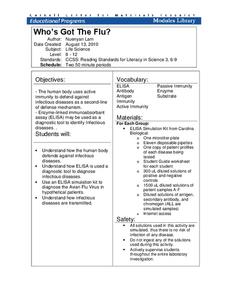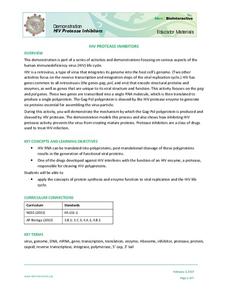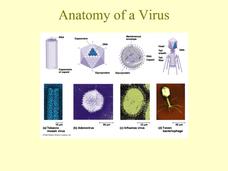Curated OER
Antibiotics: Will They Work?
Students examine why antibiotics are important in everyday life. They examine the decisions that people make and how these decisions can artificially speed up natural selection in bacteria that cause infections such as group A...
Curated OER
Food-Borne Illnesses
Use this lesson to have your charges consider the differences between food spoilage and food-borne illnesses including the differentiation of food infections and food intoxication, including characteristics of each. Some excellent...
Curated OER
Nelson's Dream
Students explore fatal diseases by researching Africa. In this AIDS lesson, students read fictional stories about African men and women who are infected with AIDS and very sick. Students define several disease related vocabulary terms...
Howard Hughes Medical Institute
Viral DNA Integration
How do viruses hijack our cells to produce more viral particles? Junior immunologists model how viral RNA integrates into a host cell's DNA using pop beads and use interactive tools to explore a virus' genome. The teacher's guide...
US National Library of Medicine
Science and Society: Preventing the Spread of Disease
Looking for a valuable resource on the spread of infectious diseases? Here is a lesson in which pupils simulate the spread of diseases and learn about how to prevent them from spreading. Class members read case studies about diseases,...
Centers for Disease Control and Prevention
Understanding the Epidemiologic Triangle through Infectious Disease
Introduce infectious diseases and the epidemiologic triangle. A helpful resource describes the agent, host, and environment from the three vertices as well as the time factor, which is in the middle. Scholars complete a simple...
Centers for Disease Control and Prevention
Microbe Multiplication Magic
A instructional activity introduces the reproduction rate of E. coli though a video. Then scholars complete a data table and graph of reproduction rates in ideal conditions as well as less than ideal conditions.
Virginia Department of Education
The Germ Theory and Koch’s Postulates
Explore the history of cholera and its effect on society with your biology class. Young biologists will then proceed to grow their own germs, prepared from live cultures, and follow the steps of the scientific method to generate data....
Give and Let Live
Blood and Transplant: Organs
Who donates organs, and how do organ donations work? The third lesson in a four-part series discusses the tremendous need for donor organs of all ages and backgrounds. A variety of materials, included with the teacher's guide, walk...
Cornell University
Who’s Got The Flu?
Become an immunologist for the day. Scholars elicit the use of the enzyme-linked immunoabsorbent assay (ELISA) to diagnose an infectious disease. Through the process, they learn about the immune system response to infectious diseases.
Howard Hughes Medical Institute
HIV Protease Inhibitors
How do doctors fight a virus that's constantly mutating? Show science scholars how we fight HIV using one of its own most fundamental processes through a thoughtful demonstration. The lesson focuses on how protease inhibitors prevent HIV...
Curated OER
Sexually Transmitted Diseases - Day 5: Communication
How does one have a discussion with a partner about a sexually transmitted disease? This is probably not a conversation that happens to be in everyone's repertoire. This lesson presents some role-playing scenarios that your class can...
Curated OER
Studying Contraception
Abstinence, different contraceptives, decision-making about sexual activity, and peer pressure are a few of the topics in this lesson. Did you know the majority of youth are not sexually active? This would be a great jumping off point...
Curated OER
Examining Abstinence
Highschoolers investigate the concept of abstinence and how it is considered the safest expression of teen sexuality. Guiding questions are used to help students through the lesson. There are many components to this lesson which take a...
Curated OER
Understanding and Avoiding HIV/AIDS
Students explore myths and facts pertaining to AIDS. In this AIDS/HIV lessons, students listen to their instructor deliver a lecture regarding the disease and then play a true or false game based on the lecture.
Children’s Hospital of Philadelphia
Case Studies: Influenza and HIV
Stop infection spread. Pupils participate in an activity to model infections and replications of viruses. Within the activity, scholars see that viruses may end up with genetic variation and connect that to how some forms of the flu are...
Curated OER
Raw Seafood ~ On the Half Shell
The topic is fascinating, but there is not much for learners to do here. Food borne illness has always been a problem for humans to face, and here, data from the Center for Disease Control is analyzed. Learners look at the number of...
Curated OER
Anatomy of a Virus
This PowerPoint summarizes details about the virus from the structure and reproduction methods to the different modes of infection. Various viral diseases of animals and plants, viroids, prions and genetic origins of viruses are discussed.
Curated OER
Entomologists on Safari: On the Hunt for Mosquitoes
Students research about the symptoms of West Nile Virus. In this health lesson, students play the role of scientists investigating mosquito activity in a fictional community. They suggest ways to prevent West Nile virus infection by...
Curated OER
AIDS, HIV, & Other Microbe Matters
Students conduct inquiry-based research for basic information about microbes, infections, and HIV, the virus that causes AIDS. After gathering answers to their questions, students develop a presentation to post on their school's Web site.
Nemours KidsHealth
Germs: Grades 3-5
Students investigate personal health issues by discussing germs. In this contagious disease lesson plan, students identify ways germs infect our bodies and how we can best protect ourselves. Students discuss food preparation and safety...
Curated OER
Tracking a Virus
Students simulate the spread of a virus such as HIV through a population by "sharing" (but not drinking) the water in a plastic cup with several classmates. Although invisible, the water in a few of the cups will already be tainted with...
Curated OER
Pandemic Flu
Students review the difference between viruses and bacteria, and provide examples of illnesses that each can cause. To help students comprehend how quickly an influenza infection can spread, they perform an activity. They are placed in...
Curated OER
Breaking News: Shopping Carts Covered in Bacteria (5th March, 2011)
Students explore current events by completing several worksheet activities. In this bacteria infections lesson, students read a current news story of the germs associated with shopping carts and how people should protect themselves....
Other popular searches
- Bacterial Infections
- Viral Infections
- Infection Control
- Chain of Infection
- Nursing Infection Control
- Germ Theory of Infection
- Infection Antibiotics
- Infection Control Chain
- Bacterial and Viral Infections
- Preventing Infection
- Hiv Infection
- Infection Control and Safety








